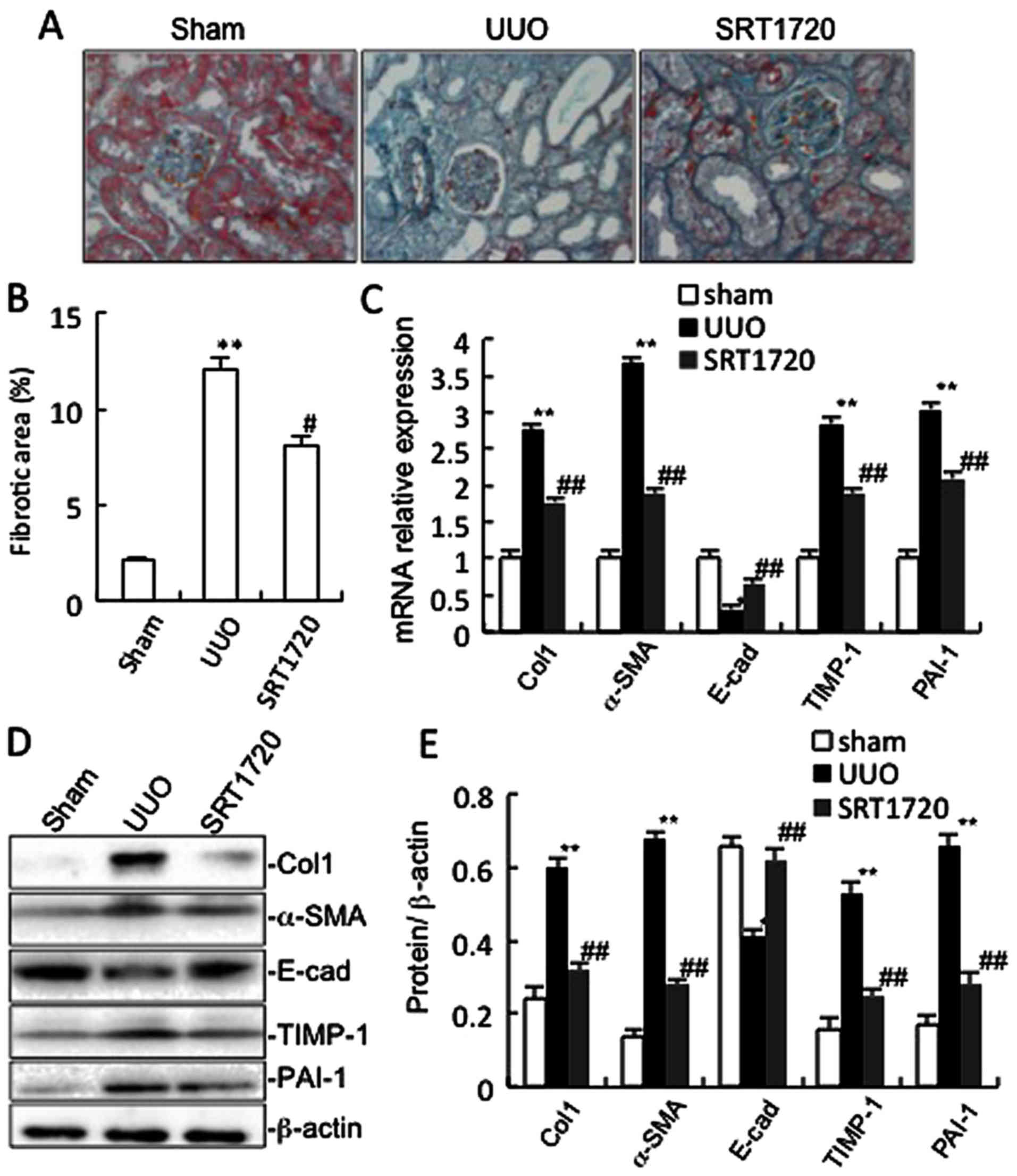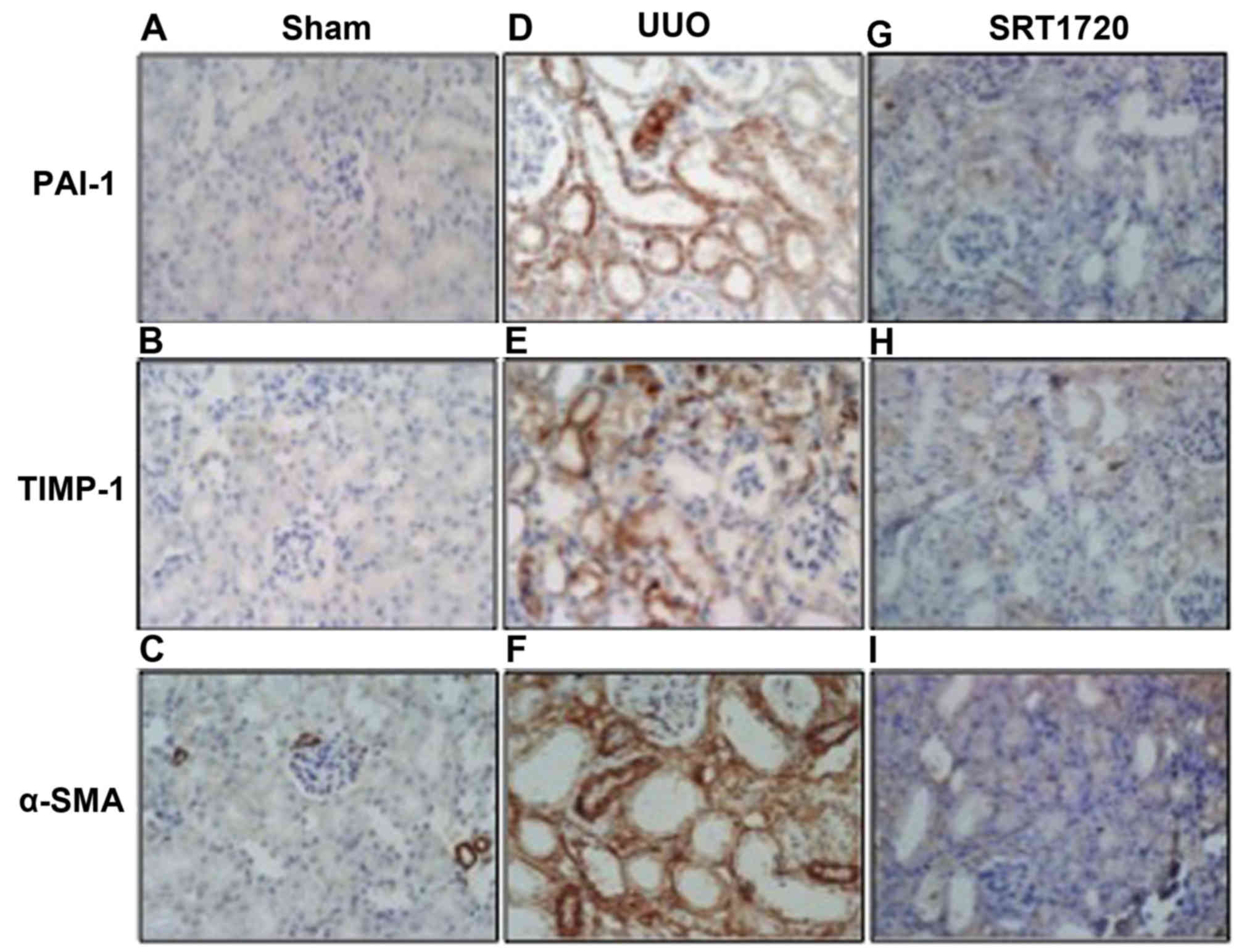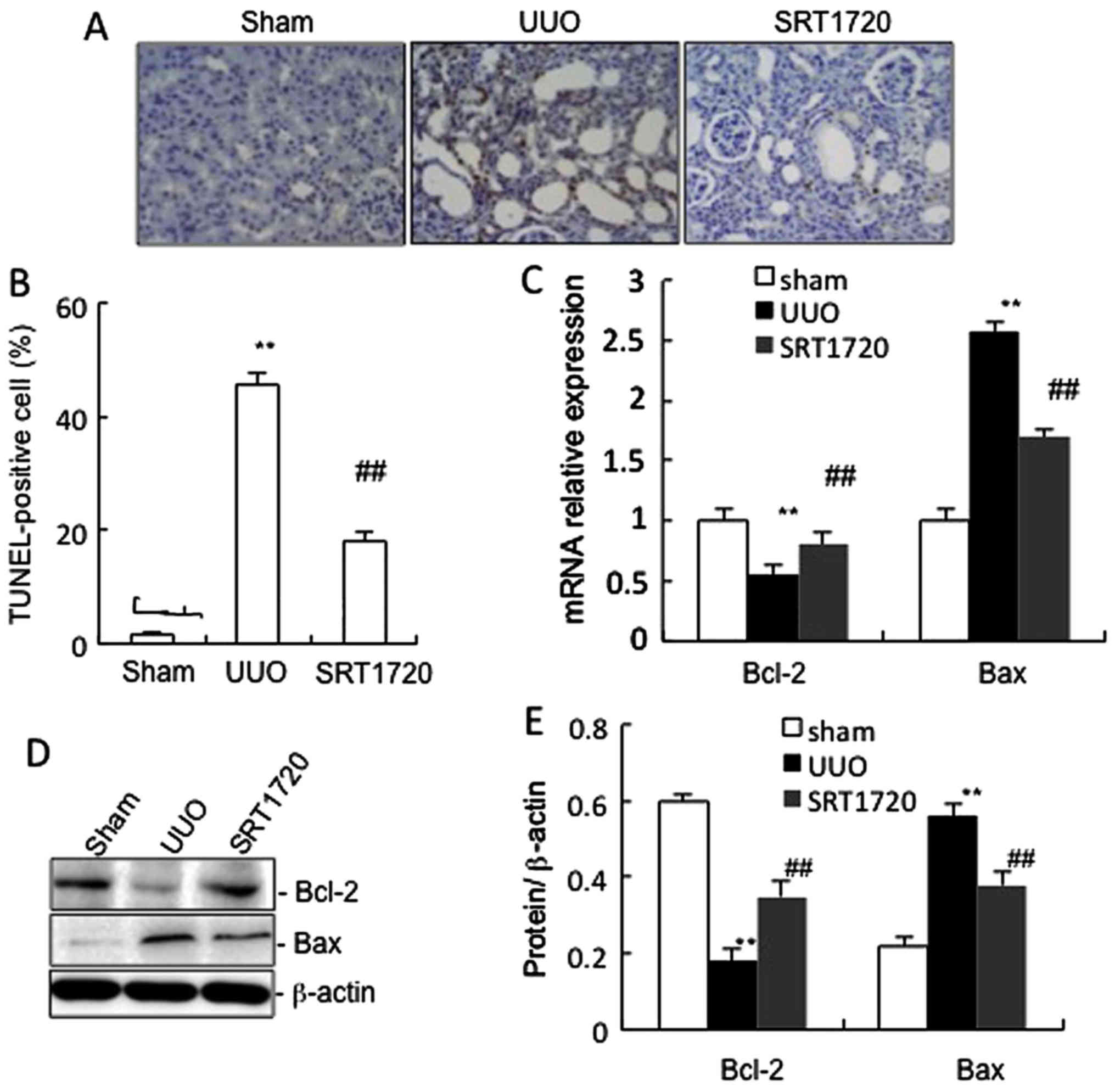|
1
|
Klahr S and Morrissey J: Obstructive
nephropathy and renal fibrosis. Am J Physiol Renal Physiol.
283:F861–F875. 2002. View Article : Google Scholar : PubMed/NCBI
|
|
2
|
Leask A and Abraham DJ: TGF-beta signaling
and the fibrotic response. FASEB J. 18:816–827. 2004. View Article : Google Scholar : PubMed/NCBI
|
|
3
|
Devarajan P: Update on mechanisms of
ischemic acute kidney injury. J Am Soc Nephrol. 17:1503–1520. 2006.
View Article : Google Scholar : PubMed/NCBI
|
|
4
|
Chiu C, Maddock DA, Zhang Q, Souza KP,
Townsend AR and Wan Y: TGF-beta-induced p38 activation is mediated
by Rac1-regulated generation of reactive oxygen species in cultured
human keratinocytes. Int J Mol Med. 8:251–255. 2001.PubMed/NCBI
|
|
5
|
Herrera B, Alvarez AM, Sánchez A,
Fernández M, Roncero C, Benito M and Fabregat I: Reactive oxygen
species (ROS) mediates the mitochondrial-dependent apoptosis
induced by transforming growth factor (β) in fetal hepatocytes.
FASEB J. 15:741–751. 2001. View Article : Google Scholar : PubMed/NCBI
|
|
6
|
Michan S and Sinclair D: Sirtuins in
mammals: Insights into their biological function. Biochem J.
404:1–13. 2007. View Article : Google Scholar : PubMed/NCBI
|
|
7
|
Kim DH, Jung YJ, Lee JE, Lee AS, Kang KP,
Lee S, Park SK, Han MK, Lee SY, Ramkumar KM, et al: SIRT1
activation by resveratrol ameliorates cisplatin-induced renal
injury through deacetylation of p53. Am J Physiol Renal Physiol.
301:F427–F435. 2011. View Article : Google Scholar : PubMed/NCBI
|
|
8
|
Huang XZ, Wen D, Zhang M, Xie Q, Ma L,
Guan Y, Ren Y, Chen J and Hao CM: Sirt1 activation ameliorates
renal fibrosis by inhibiting the TGF-β/Smad3 pathway. J Cell
Biochem. 115:996–1005. 2014. View Article : Google Scholar
|
|
9
|
Kume S, Haneda M, Kanasaki K, Sugimoto T,
Araki S, Isshiki K, Isono M, Uzu T, Guarente L, Kashiwagi A, et al:
SIRT1 inhibits transforming growth factor beta-induced apoptosis in
glomerular mesangial cells via Smad7 deacetylation. J Biol Chem.
282:151–158. 2007. View Article : Google Scholar
|
|
10
|
Mao B, Hu F, Cheng J, Wang P, Xu M, Yuan
F, Meng S, Wang Y, Yuan Z and Bi W: SIRT1 regulates YAP2-mediated
cell proliferation and chemoresistance in hepatocellular carcinoma.
Oncogene. 33:1468–1474. 2014. View Article : Google Scholar
|
|
11
|
Milne JC, Lambert PD, Schenk S, Carney DP,
Smith JJ, Gagne DJ, Jin L, Boss O, Perni RB, Vu CB, et al: Small
molecule activators of SIRT1 as therapeutics for the treatment of
type 2 diabetes. Nature. 450:712–716. 2007. View Article : Google Scholar : PubMed/NCBI
|
|
12
|
Gano LB, Donato AJ, Pasha HM, Hearon CM
Jr, Sindler AL and Seals DR: The SIRT1 activator SRT1720 reverses
vascular endothelial dysfunction, excessive superoxide production,
and inflammation with aging in mice. Am J Physiol Heart Circ
Physiol. 307:H1754–H1763. 2014. View Article : Google Scholar : PubMed/NCBI
|
|
13
|
Shimizu H, Maruyama S, Yuzawa Y, Kato T,
Miki Y, Suzuki S, Sato W, Morita Y, Maruyama H, Egashira K, et al:
Antimonocyte chemoattractant protein-1 gene therapy attenuated
renal injury induced by protein-overload proteinuria. J Am Soc
Nephrol. 14:1496–1505. 2003. View Article : Google Scholar : PubMed/NCBI
|
|
14
|
Livak KJ and Schmittgen TD: Analysis of
relative gene expression data using real-time quantitative PCR and
the 2(−ΔΔC(T)) method. Methods. 25:402–408. 2001. View Article : Google Scholar
|
|
15
|
Duymelinck C, Deng JT, Dauwe SE, De Broe
ME and Verpooten GA: Inhibition of the matrix metalloproteinase
system in a rat model of chronic cyclosporine nephropathy. Kidney
Int. 54:804–818. 1998. View Article : Google Scholar : PubMed/NCBI
|
|
16
|
Yang J and Liu Y: Dissection of key events
in tubular epithelial to myofibroblast transition and its
implications in renal interstitial fibrosis. Am J Pathol.
159:1465–1475. 2001. View Article : Google Scholar : PubMed/NCBI
|
|
17
|
He W, Wang Y, Zhang MZ, You L, Davis LS,
Fan H, Yang HC, Fogo AB, Zent R, Harris RC, et al: Sirt1 activation
protects the mouse renal medulla from oxidative injury. J Clin
Invest. 120:1056–1068. 2010. View
Article : Google Scholar : PubMed/NCBI
|
|
18
|
Kume S, Haneda M, Kanasaki K, Sugimoto T,
Araki S, Isono M, Isshiki K, Uzu T, Kashiwagi A and Koya D: Silent
information regulator 2 (SIRT1) attenuates oxidative stress-induced
mesangial cell apoptosis via p53 deacetylation. Free Radic Biol
Med. 40:2175–2182. 2006. View Article : Google Scholar : PubMed/NCBI
|
|
19
|
Chuang PY, Dai Y, Liu R, He H, Kretzler M,
Jim B, Cohen CD and He JC: Alteration of forkhead box O (foxo4)
acetylation mediates apoptosis of podocytes in diabetes mellitus.
PLoS One. 6:e235662011. View Article : Google Scholar : PubMed/NCBI
|
|
20
|
Liu Y: Cellular and molecular mechanisms
of renal fibrosis. Nat Rev Nephrol. 7:684–696. 2011. View Article : Google Scholar : PubMed/NCBI
|
|
21
|
Franklin TJ: Therapeutic approaches to
organ fibrosis. Int J Biochem Cell Biol. 29:79–89. 1997. View Article : Google Scholar : PubMed/NCBI
|
|
22
|
Sánchez-López E, Rodrigues Díez R,
Rodríguez Vita J, Rayego Mateos S, Rodrigues Díez RR, Rodríguez
García E, Lavoz Barria C, Mezzano S, Egido J, Ortiz A, Ruiz-Ortega
M and Selgas R: Connective tissue growth factor (CTGF): a key
factor in the onset and progression of kidney damage. Nefrologia.
29:382–391. 2009.In Spanish.
|
|
23
|
Border WA and Noble NA: Transforming
growth factor beta in tissue fibrosis. N Engl J Med. 331:1286–1292.
1994. View Article : Google Scholar : PubMed/NCBI
|
|
24
|
Ito Y, Aten J, Bende RJ, Oemar BS,
Rabelink TJ, Weening JJ and Goldschmeding R: Expression of
connective tissue growth factor in human renal fibrosis. Kidney
Int. 53:853–861. 1998. View Article : Google Scholar : PubMed/NCBI
|
|
25
|
Yokoi H, Sugawara A, Mukoyama M, Mori K,
Makino H, Suganami T, Nagae T, Yahata K, Fujinaga Y, Tanaka I, et
al: Role of connective tissue growth factor in profibrotic action
of transforming growth factor-beta: A potential target for
preventing renal fibrosis. Am J Kidney Dis. 38(Suppl 1): S134–S138.
2001. View Article : Google Scholar : PubMed/NCBI
|
|
26
|
Modi KS, Morrissey J, Shah SV, Schreiner
GF and Klahr S: Effects of probucol on renal function in rats with
bilateral ureteral obstruction. Kidney Int. 38:843–850. 1990.
View Article : Google Scholar : PubMed/NCBI
|
|
27
|
Sunami R, Sugiyama H, Wang DH, Kobayashi
M, Maeshima Y, Yamasaki Y, Masuoka N, Ogawa N, Kira S and Makino H:
Acatalasemia sensitizes renal tubular epithelial cells to apoptosis
and exacerbates renal fibrosis after unilateral ureteral
obstruction. Am J Physiol Renal Physiol. 286:F1030–F1038. 2004.
View Article : Google Scholar : PubMed/NCBI
|














